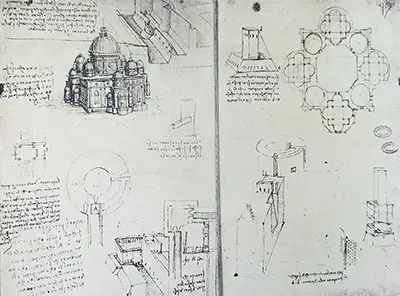Da Vinci was undeniably a talented and versatile individual, where even the word artist would be too restrictive for him. He famously produced some of the most famous paintings in the world, but was also involved in the formulation of inventions as well as architectural designs, such as the ones found here. He would fill his pages with all manner of different ideas, and then sometimes write down notes alongside them, with perhaps an idea for a later amendment. Paper was not as readily available as it is today and so these musings would be placed together in order to allow each piece to serve as much purpose as possible. The artist would do much the same with his anatomical drawings, often featuring different individual limb studies together in close proximity, even though they were ultimately unrelated artworks.
The majority of this series of drawings, dedicated to the same architectural project, are now stored in the Bibliotheque de l'institut de France. Access, one assumes, would be limited because of the fragile nature of drawings from so many centuries ago, as well as the huge cultural and monetary value attributed to anything that came from the hand of this Renaissance master. Digital copies have been made of all his work in order to allow us to view them from a safe distance and these have been included within some of the many publications of his life that have come about over the past two centuries. There has also recently been an increased interest in learning more about the lesser known items from his career, rather than only ever focusing on his famous paintings, which always used to be the case. This allows exhibitions of his work to be more varied and interesting, and also allows curators to more easily arrange the loaning of items such as these.
Da Vinci was most focused on the exterior facade of the building here, as well as considering elements of the floor structure. He was an artist by trade by was able to understand engineering principles particularly well and over time would fill in any blanks through experience, by working on a number of different projects. Da Vinci was extraordinarily curious when it came to different artistic disciplines and this encouraged him to try out so many different options during his career. His passion and hard working nature allowed him to catch up with specialists and he would also collaborate on occasion if he felt it necessary. In terms of completing some of these projects, he would also make use of a team of assistants to help on the larger works, whilst he focused more on an advisory or supervisory role once his own designs and plans had been completed.

